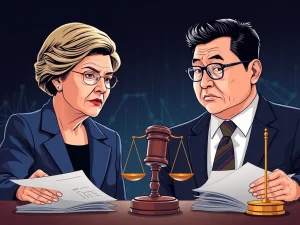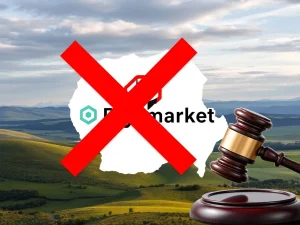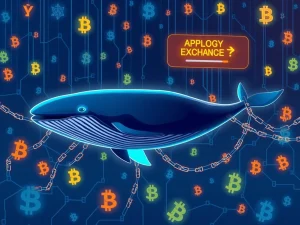Stablecoin Regulation Sparks Urgent Rise of Dark Stablecoins

For many in the crypto world, stablecoins have been a crucial tool for storing value and moving funds without traditional banking hurdles. However, increasing government oversight is changing the landscape. This shift is prompting discussions about the potential emergence of ‘dark stablecoins’ as users seek alternatives to regulated options.
The Catalyst: Stablecoin Regulation Intensifies
The push for stricter stablecoin regulation is gaining momentum globally. Governments and financial bodies are looking to bring stablecoins under existing or new regulatory frameworks, similar to traditional financial instruments. The core idea is to ensure stability, prevent illicit use, and integrate them safely into the financial system.
Ki Young Ju, CEO of CryptoQuant, highlighted this trend, stating that stablecoins issued by countries could soon face significant government regulation. This could include features like automated tax collection via smart contracts or wallet freezing based on government rules. This increasing control could make currently popular stablecoins less appealing for users prioritizing privacy or needing to make large international transfers without scrutiny.
Understanding the Need for Censorship Resistant Stablecoins
The primary driver behind the potential demand for censorship resistant stablecoins is the desire to avoid government interference. As regulations mandate Know Your Customer (KYC) checks, transaction monitoring, and potential asset freezing, some users may look for stablecoins that operate outside these controls. This mirrors the historical use of certain cryptocurrencies for privacy-focused transactions.
What Are ‘Dark Stablecoins’ and How Could They Emerge?
The term ‘dark stablecoins‘ refers to stablecoins designed to be censorship-resistant and potentially operate outside the reach of traditional financial regulations. Ki Young Ju speculates on several potential forms:
-
Algorithmic Stablecoins: Unlike stablecoins backed 1:1 by reserves (like USD or gold), algorithmic stablecoins maintain their peg through complex mechanisms involving supply and demand adjustments, often linked to other cryptocurrencies. This decentralized structure can make them less susceptible to direct government seizure or control over reserves.
-
Decentralized Oracles: A dark stablecoin could potentially track the price of regulated coins like USDC using decentralized data oracles (like Chainlink) but operate on a privacy-focused blockchain or protocol.
-
Non-Compliant Issuers: Stablecoins issued by entities or countries that choose not to comply with regulations from major jurisdictions (like the US or EU) could effectively function as dark stablecoins in those regulated environments. Ki Young Ju specifically mentioned Tether USDT, noting that if Tether chose not to comply with future US regulations, it could be perceived as a dark stablecoin in a highly regulated internet economy.
Crypto Privacy Technology Provides a Blueprint
The concept of privacy in digital transactions is not new to crypto. Existing cryptocurrencies already offer enhanced crypto privacy features. While not stablecoins, projects like Zcash (ZEC) and Monero (XMR) use advanced cryptographic techniques (like zero-knowledge proofs or ring signatures) to shield transaction details, making it difficult to trace sender, receiver, or transaction value on the blockchain.
Several projects are exploring how to apply similar privacy technology to stablecoins. Examples include Zephyr Protocol, a Monero fork focusing on private stablecoin transactions, and PARScoin, which also aims to hide user identities and transaction details. This existing technology base could provide the foundation for future dark stablecoin implementations.
The Growing Stablecoin Market and Future Outlook
Despite the regulatory focus, the stablecoin market continues its significant growth. A recent Citigroup report highlighted that the market cap for US dollar-denominated stablecoins exceeded $230 billion in April, a 54% increase year-over-year. Tether (USDT) and USDC dominate this market, holding about 90% combined. Total stablecoin volumes in 2024 have already surpassed the combined volumes of Visa and Mastercard. This demonstrates the critical role stablecoins play in the crypto ecosystem and global transfers.
The potential emergence of dark stablecoins is a direct response to the evolving regulatory landscape. As governments impose stricter controls on mainstream stablecoins, a segment of users may seek out alternatives that offer greater privacy and censorship resistance, potentially leveraging existing or new crypto privacy technologies.
Summary
Increased global stablecoin regulation is a certainty, with frameworks like EU’s MiCA and potential US laws on the horizon. This regulatory pressure, while aimed at safety and compliance, could inadvertently fuel demand for censorship resistant stablecoins. Experts like Ki Young Ju predict the rise of ‘dark stablecoins,’ which could take forms like algorithmic designs, non-compliant issuers (such as Tether USDT under certain conditions), or offshore operations. Leveraging existing crypto privacy technologies found in coins like Monero and Zcash, these dark stablecoins would aim to offer users the ability to transact and store value outside the purview of government oversight. The future of the stablecoin market may see a bifurcation between highly regulated, compliant options and more private, decentralized alternatives.









